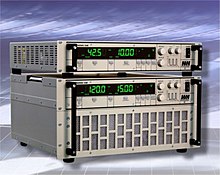Dummy load
A dummy load is a device used to simulate an electrical load, usually for testing purposes. In radio a dummy antenna is connected to the output of a radio transmitter and electrically simulates an antenna, to allow the transmitter to be adjusted and tested without radiating radio waves. In audio systems, a dummy load is connected to the output of an amplifier to electrically simulate a loudspeaker, allowing the amplifier to be tested without producing sound. Load banks are connected to electrical power supplies to simulate the supply's intended electrical load for testing purposes.


Radio

In radio this device is also known as a dummy antenna or a radio frequency termination. It is a device, usually a resistor, used in place of an antenna to aid in testing a radio transmitter. It is substituted for the antenna while one adjusts the transmitter, so that no radio waves are radiated so that the transmitter does not interfere with other radio transmitters during the adjustments. (As no dummy load is ideal, however, some radiation does occur). [1] If a transmitter is tested without a load attached to its output terminals such as an antenna or a dummy load, the power will be reflected back into the transmitter, often overheating and damaging it. Also, if a transmitter is adjusted without a load, it will operate differently as compared with a load, and the adjustments may be incorrect.
The dummy load ordinarily should be a pure resistance; the amount of resistance should be the same as the impedance of the antenna or transmission line that is used with the transmitter (usually 50 Ω or 75 Ω).[2] The radio energy that is absorbed by the dummy load is converted to heat. A dummy load must be chosen or designed to tolerate the amount of power that can be delivered by the transmitter.[3] Typically it consists of a resistor attached to some type of heat sink to dissipate the power from the transmitter.
The ideal dummy load provides a standing wave ratio (SWR) of 1:1 at the given impedance.
Veterinarian-grade mineral oil, an inexpensive form of mineral oil, is frequently used by amateur radio operators as coolant in RF dummy loads.
Audio

When testing audio amplifiers, it is common to replace the loudspeaker with a dummy load, so that the amplifier's handling of large power levels can be tested without actually producing intense sound. The simplest is a resistor bank to simulate the voice coil's resistance.
For loudspeaker simulation, a more complex network is more accurate, however, as actual loudspeakers are reactive and non-linear. There are many designs for loudspeaker simulators, which emphasize different characteristics of the actual speaker, such as the voice coil's inductance, mechanical suspension compliance, and cone mass.
Power supplies
There are also dummy loads for power supplies, known as load banks. These may be used, for example, for factory and in-service testing of standby generators. A load bank may be used to stabilize a power system in case of loss of load, for example, on an isolated wind or mini-hydro plant.
An electronic load (or e-load) is a device or assembly that simulates loading on an electronic circuit. It is used as substitute for a conventional ohmic load resistor.

As counterpart to a current source, the electronic load is a current sink. When loading a current source with a fixed resistor one can set one determined load current by the connected load resistor. The characteristic of the electronic load is that the load current can be set and varied in a defined range. The load current is regulated electronically.
The electronic load consumes electric energy and in most cases transforms it into heat. Fans or water-cooled elements are used as coolers. Under certain conditions, energy-recycling into the public power supply system is also possible.
Electronic loads are used in diverse applications, particularly for the test of power supplies, batteries, solar and fuel cells, generators. AC loads are used to test transformers, uninterruptible power supplies (UPS) or onboard power supplies. The equipment and power spectrum of such electronic loads begins with simplest circuits consisting in general of a potentiometer for current setting and a transistor circuit for power transforming. Further developed electronic loads supply several operating modes, in most cases constant current, voltage, power and resistance. Nowadays, the equipment may be controlled by a PLC or remotely by a PC. Settings and measured values such as input voltage and actual load current are indicated on a display.
References
- Kleinschmidt, Kirk, ed. (1990). ARRL Handbook for the Radio Amateur. Newington, Connecticut: American Radio Relay League. pp. 25–21 through 25–23.
- Kleinschmidt, Kirk, ed. (1990). ARRL Handbook for the Radio Amateur. Newington, Connecticut: American Radio Relay League. pp. 25–21.
- Kleinschmidt, Kirk, ed. (1990). ARRL Handbook for the Radio Amateur. Newington, Connecticut: American Radio Relay League. pp. 34–22 through 34–28.
Further reading
- Ausias Garrigós; José M Blanes (2005-03-17). "Power MOSFET is core of regulated-dc electronic load". EDN.
- Martin Rowe (2005-12-01). "Loads need calibration, too". Ensuring power supply accuracy. Test and Measurement World.
- M. B. Borage; S. R. Tiwari; S. Kotaiah (2003-07-07). "Inductive electronic load for testing of magnet power supplies in particle accelerators". Review of Scientific Instruments. 74 (12): 5194–5196. Bibcode:2003RScI...74.5194B. doi:10.1063/1.1622971.
- Meng-Yueh Chang; Jiann-Yow Lin; Shih-Liang Jung; Ying-Yu Tzou (1997-06-27). "Design and implementation of a real-time lossless dynamic electronic load simulator". PESC97. Record 28th Annual IEEE Power Electronics Specialists Conference. Formerly Power Conditioning Specialists Conference 1970-71. Power Processing and Electronic Specialists Conference 1972. Vol. 1. pp. 734–739. doi:10.1109/PESC.1997.616801. ISBN 0-7803-3840-5. S2CID 111355663.
- Singh, B.; Murthy, S.S.; Gupta, S. (2004). "Analysis and implementation of an electronic load controller for a self-excited induction generator". IEE Proceedings - Generation, Transmission and Distribution. 151: 51. doi:10.1049/ip-gtd:20040056.
External links
- Speaker impedance - ePanorama.net